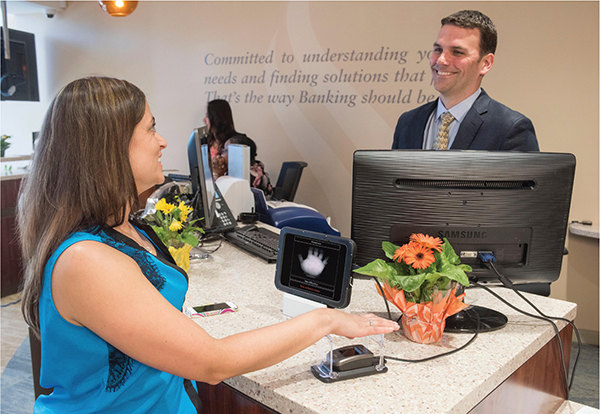The $1.6 billion, Richland, Wash.-based Gesa Credit Union is reading palms – not to tell the future, but to improve it by reducing identity fraud, shrinking transaction times and improving overall branch service.
To accomplish this feat, the credit union employed the Brookfield, Wis.-based core processor Fiserv's Verifast: Palm Authentication. The solution integrates Fujitsu PalmSecure biometric technology with the Fiserv's DNA account processing platform. The Verifast solution validates members' IDs when they hold their hand over an infrared sensing device that detects a person's unique palm vein pattern.
“Overall we think this is an excellent solution for our credit union to move forward into the future of how we transform and deliver service to our members,” Gesa Director of Products Karl Guynn said.
According to Fiserv, this technology can increase authentication speed by more than 90%. Palm authentication also helps enhance efficiency for credit unions by reducing keystrokes, eliminating search screens and inaccurate selections, minimizing errors and speeding up transactions.
“We focus on enabling a better experience at the branch by trying to streamline the authentication process,” Chris Van Der Stad, SVP/chief technology officer, Open Solutions for Fiserv, said. “We realized there was a lot of back and forth in trying to have a member prove they are who they say they are. That includes producing a driver's license or other forms of identification. Fiserv has enabled and leveraged biometrics in order to speed that up and make the process more secure.”
Gesa's palm installation project began when Fiserv approached the credit union to be a beta test client.
“This solution looked like a fit for us,” Guynn said. “Especially since many credit union members are very technical. A lot of our members are scientists or use technology on a daily basis.”
Join us in Dallas at the new Credit Union Times Fraud: Don't Let It Happen To Your Credit Union Conference, where you will find the latest tools and techniques for preventing fraud and data breaches; strategies for responding in the immediate aftermath and best practices for restoring reputation, financial stability and information security. This two-day conference is designed for credit union executives, board of directors and those responsible for your credit unions cyber security policy. Register to attend and save $150.
In addition, some of Gesa's branches are transaction-heavy, and the credit union wanted to add an extra security layer to protect against ID fraud.
“We went through the various models of the tablet device, which is the member interface, and how the registration works, what we needed to do and how it interfaced with the core,” Guynn recalled.
The actual palm scan pilot began in October 2015 at three Gesa branches. Gesa utilized signage to promote the pilot and devoted one station at each location to the registration process, which records a palm vein pattern in about 40 seconds.
The credit union tied the biometric pilot into the Star Wars: The Force Awakens film release. “We looked at it as Star Wars technology for our members and they loved that aspect of it,” Guynn recalled. “Once they started using it, they always wanted to go to that line.”
The pilot ran for three months through the holiday season.
The credit union also used surveys to gather member feedback and demographic information. The survey results were surprising in many ways, Guynn noted.
“Across all demographic groups, 99.9% of the responses were five out of five, with most comments [stating], 'Yes, please give us this technology.'”
Not only did the solution authenticate members – it also streamlined interaction times.
“We benchmarked our traditional process and found that it takes about 15 seconds for a member to authenticate themselves at a teller station,” Guynn said. “Palm vein authentication takes about one second, so we've shaved 14 seconds off each transaction. Palm vein authentication speeds up the transaction so members can be in and out of the branch and on with their lives. It's more secure and our members and tellers love it.”
Van Der Stad added, “The use of biometric technology such as palm scans for authentication can provide added security beyond conventional systems. The Verifast: Palm Authentication technology eliminates the need for consumers to scramble for their IDs or exchange personal information. It delivers a combination of convenience and security that complements how people live today.”
 Palm scan technology is an exceptionally secure and accurate form of authentication. Palm vein patterns are complex, with more than five million reference points. And the veins, hidden under the skin, remain stable throughout a person's life.
Palm scan technology is an exceptionally secure and accurate form of authentication. Palm vein patterns are complex, with more than five million reference points. And the veins, hidden under the skin, remain stable throughout a person's life.
“It is very secure and very easy to use,” Van Der Stad said. “There is no way to fake it or get around it. It has to be [the member's] palm.”
Positive results from the Gesa pilot led to plans to offer the service at five additional branches.
“We've moved from pilot to implementation,” Guynn said, adding the credit union dedicated one teller line to palm authentication in each of its eight heavy-transaction branches. Gesa has 16 branches.
“We're reducing our wait times and giving better member service using a secure method,” Guynn explained.
Here's how the palm vein authentication works: Each member approaches the teller and holds their hand over the biometric scanner, which reads the veins in their palm, captures a digital signature and matches it up in the core system in seconds.
Behind the scenes, Verifast's SQL database ties the palm vein pattern to a member database number. The Verifast database links the number, which the member does not know, to Fiserv's DNA core, which then displays the member's profile.
To create more efficiency, Van Der Stad noted, Verifast: Palm Authentication not only manages member identification but instructs DNA to prefill the teller screen to hasten the process.
DNA also displays the member's driver's license information so tellers get an even more complete security check.
“We can then do whatever we need to do,” Guynn explained. “We see the 360 view of that member.”
Guynn noted palm vein recognition technology uses are limitless. Gesa is looking at implementing the technology into ATMs, Internet of Things devices, teller stations as part of its self-service strategy and possibly safe deposit boxes.
“The possibility is that it is limitless regarding the staff, in that they can log into Windows or different DNA applications, or enter credit union buildings [without] access cards,” Guynn added. “We're looking at this as a possibility of transforming everything, not only as a means of authentication but creating efficiencies in the branches.”
He added, “Security is a big deal to our members. Offering a biometric authentication capability like Verifast: Palm Authentication demonstrates to our members that it is a big deal to us too.”
According to Raddon Financial Group research, 83% of consumers perceive palm authentication to be somewhat to extremely valuable for banking transactions. In surveys of consumer beta testers, 97% of consumers who have tried the technology reported they are likely to use it again in the branch environment.
In a recent report, the global financial services industry association Mobey Forum noted how biometrics has become a mainstream activity in the financial services industry and payments systems over the last two decades.
In addition, Technavio's analysts forecasted the global vein recognition biometrics market in the banking and financial services industry sector to grow at a compound annual growth rate of almost 28% by 2019. Several banks in Japan have used palm vein authentication technology for customer identification since 2004.
“The roadmap is strong for [Verifast: Palm Authentication], the interest is strong from our existing clients and we are looking at integrating it with other products across Fiserv,” Van Der Stad added.
Join us in Dallas at the new Credit Union Times Fraud: Don't Let It Happen To Your Credit Union Conference, where you will find the latest tools and techniques for preventing fraud and data breaches; strategies for responding in the immediate aftermath and best practices for restoring reputation, financial stability and information security. This two-day conference is designed for credit union executives, board of directors and those responsible for your credit unions cyber security policy. Register to attend and save $150.
© Touchpoint Markets, All Rights Reserved. Request academic re-use from www.copyright.com. All other uses, submit a request to [email protected]. For more inforrmation visit Asset & Logo Licensing.







